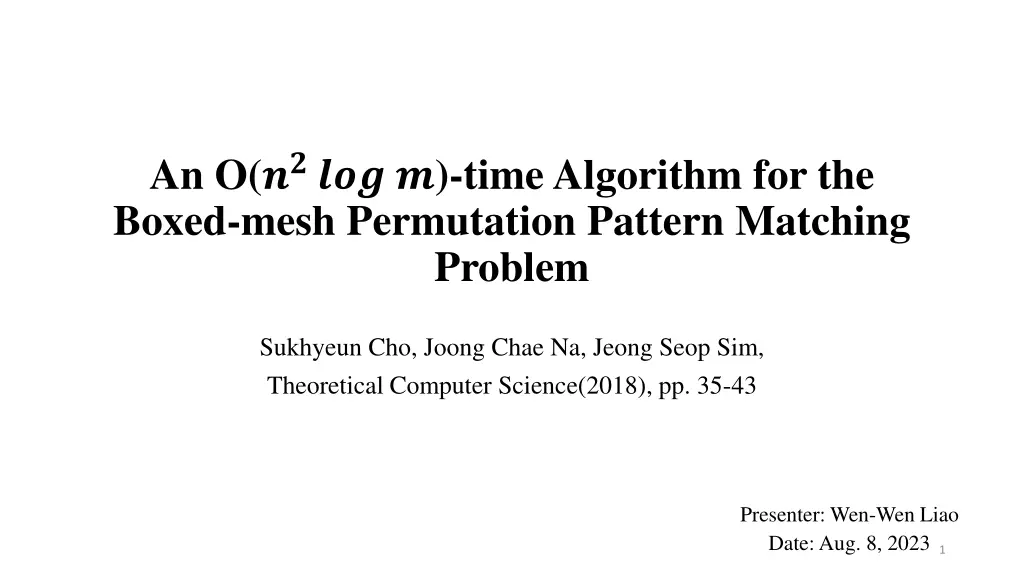
Algorithm for Boxed-Mesh Permutation Pattern Matching
"Discover an efficient O(?2????)-time algorithm for the boxed-mesh permutation pattern matching problem. The algorithm utilizes boxed subsequences and order-statistic trees, providing solutions for finding ordered character sequences in text and patterns. Explore the complexities and key findings in this theoretical computer science research."
Download Presentation

Please find below an Image/Link to download the presentation.
The content on the website is provided AS IS for your information and personal use only. It may not be sold, licensed, or shared on other websites without obtaining consent from the author. If you encounter any issues during the download, it is possible that the publisher has removed the file from their server.
You are allowed to download the files provided on this website for personal or commercial use, subject to the condition that they are used lawfully. All files are the property of their respective owners.
The content on the website is provided AS IS for your information and personal use only. It may not be sold, licensed, or shared on other websites without obtaining consent from the author.
E N D
Presentation Transcript
An O(????? ?)-time Algorithm for the Boxed-mesh Permutation Pattern Matching Problem Sukhyeun Cho, Joong Chae Na, Jeong Seop Sim, Theoretical Computer Science(2018), pp. 35-43 Presenter: Wen-Wen Liao Date: Aug. 8, 20231
Abstract Given a text T of length n and a pattern P of length m over a numeric alphabet , the boxed-mesh permutation pattern matching problem is to find all boxed-subsequences of T whose relative order between all characters is the same as that of P. In this paper, we propose an O(?2????)-time algorithm for the boxed-mesh permutation pattern matching problem based on interesting properties of boxed subsequences, using preprocessed information on P and order-statistic trees. 2
Permutation matching problem P = (5, 3, 4, 8, 9, 6, 7) T = (10, 6, 2, 7, 15, 16, 12, 19, 13, 11, 3) T = (10, 6, 7, 15, 16, 12, 13) T = (10, 2, 7, 15, 16, 12, 13) NP-hard 3
Boxed-mesh permutation pattern matching (BPPM) P = (5, 3, 4, 8, 9, 6, 7) rank(P) = (3, 1, 2, 6, 7, 4, 5) T = (10, 6, 2, 7, 15, 16, 12, 19, 13, 11, 3) rank(T) = (5, 3, 1, 4, 9, 10, 7, 11, 8, 6, 2) 4
Boxed-mesh permutation pattern matching (BPPM) P = (5, 3, 4, 8, 9, 6, 7) T = (10, 6, 7, 15, 16, 12, 13) T is a boxed subsequence of T 5
Boxed-mesh permutation pattern matching (BPPM) P = (5, 3, 4, 8, 9, 6, 7) T = (10, 6, 7, 15, 16, 12, 13) T P 6
Full-width boxed (f-boxed) T = (T[1], T[2], T[4], T[7]) = (10, 6, 7, 12) Full-width boxed: All the characters c of x such that min(x ) c max(x ) not full-width boxed full-width boxed 7
Full-width boxed (f-boxed) T = (T[1], T[2], T[4], T[7]) = (10, 6, 7, 12) Lower boundary lb(T , T [1..9]) = 2 Upper boundary ub(T , T [1..9]) = 13 8
Pivotal subsequence P = (5, 3, 4, 8, 9, 6, 7) T = (T[1], T[2], T[4], T[7]) = (10, 6, 7, 12) C1. x includes the first character of x, C2. x is an f-boxed subsequence of x, and C3. x is order-isomorphic to the prefix P[1..|x|] of P , i.e., x P[1..|x|] 9 T is a pivotal subsequence
Algorithm P = (5, 3, 4, 8, 9, 6, 7) T = (10, 6, 2, 7, 15, 16, 12, 19, 13, 11, 3) The set of all the pivotal subsequences ?9= {(10), (10, 7), (10, 6, 7), (10, 6, 7, 12), (10, 6, 7, 12, 13), (10, 6, 7, 15, 16, 12, 13)} ??9 10
Algorithm P = (5, 3, 4, 8, 9, 6, 7) T = (10, 6, 2, 7, 15, 16, 12, 19, 13, 11, 3) Example z = ??6= (10, 6, 7, 15, 16) < 19 < ???and r = Rank(T[8], z) = Rank(19, z) = 7 is equal to [|z| + 1] = [6] = 4 (10, 6, 7, 15, 16, 12) is pivotal subsequences of T[1..7] 11
Algorithm P = (5, 3, 4, 8, 9, 6, 7) T = (10, 6, 2, 7, 15, 16, 12, 19, 13, 11, 3) Example z = ??7= (10, 6, 7, 15, 16, 12) ???= 2, ???= T[8] = 19 > max(z) = 16 Since T[8] is not included in ??8 update ???= ub(??8, T [1..8]) = min( , 19) = 19 12
Algorithm P = (5, 3, 4, 8, 9, 6, 7) T = (10, 6, 2, 7, 15, 16, 12, 19, 13, 11, 3) Example z = ??8= (10, 6, 7, 15, 16, 12) ???= 2, ???= 19 ???< 13 < ???and r = Rank(T[9], z) = Rank(19, z) = 5 is equal to [|z| + 1] = [7] = 5 (10, 6, 7, 15, 16, 12, 13) is not pivotal subsequences of T[1..9] delete largest characters (15, 16) update ???= 15 13
Algorithm P = (5, 3, 4, 8, 9, 6, 7) T = (10, 6, 2, 7, 15, 16, 12, 19, 13, 11, 3) The set of all the pivotal subsequences ?9= {(10), (10, 7), (10, 6, 7), (10, 6, 7, 12), (10, 6, 7, 12, 13), (10, 6, 7, 15, 16, 12, 13)} ??9 14
Conclusion Time complexity: ?(?2????) 15
